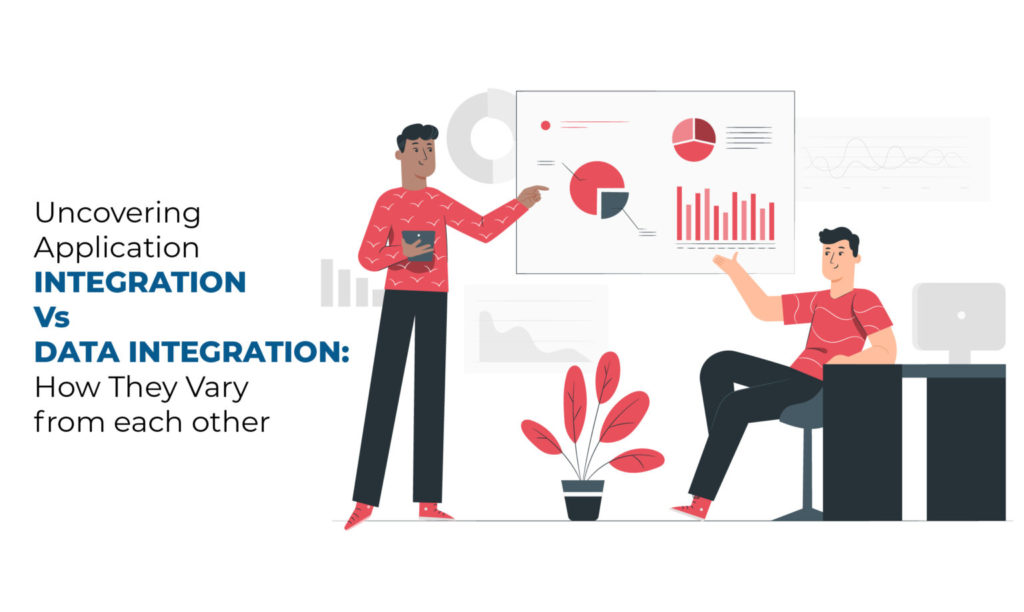Though sound similar, data and application integration are two distinct concepts, and they pose a significant challenge for every organization. The reason is simple: they need to ensure various applications hosted on-premises and in the cloud interact seamlessly, and fast and provide a correct picture of required business function.
To address these challenges, an organization needs to adopt different approaches. Data integration aims to set up a process to handle data movement between two or more databases. It typically deals with data in a batch-oriented manner, which means that the process that created the data has been completed. On the other hand, application integration is about integrating live operational data as it happens in real-time between two or more applications.
This post will try to gain a high-level overview of application and data integration and their use cases.
What is Application Integration?
When business processes involve multiple applications, live data must move from one application to another, one event at a time, in close to real-time. This might happen, for example, when an organization adds a new employee — data about the person might start in a human resources system, but also needs to be recognized in payroll and other operational applications. Application integration software can orchestrate this process by serving as middleware between systems.
Application integration is a part of the software development process by which data can be transferred between multiple OLTP applications. Application integration also requires knowledge about business or application logic, and you must understand the various application approaches while building an application integration software or creating an enterprise application integration platform.
What is Data Integration?
Put simply, data integration is the process of pulling data from multiple systems and combining them to create an analysis-ready database. Once in the database, additional analysis can be performed using tools like SQL queries and reporting, enabling companies to expand their geographies or dive deep into newly acquired data.
The question that arises here is why data integration is required in the software development process. The answer is simple: a company might receive all the data, but the problem is the data resides in different silos. To make sense of this disparate data, IT managers need to focus on building a robust data integration platform. A typical data integration solution may require combining data from CRM systems, web traffic, and marketing automation software, to name a few.
Unlike application data schemas, data integration in the data warehouse requires creating tables and columns so that data engineers can add or delete tables as per requirement.
Application Integration Vs Data Integration
Application integration is a real-time process that helps businesses collect relevant information from multiple sources and instantly provide uniform access to the information within an application. Application integrations can be part of DevOps (software development), but they also work with smaller data sets and are used for improved workflow and better data quality. Data integration deals with large data sets at rest and occurs after creating new data sets. You will need it to combine static data and analyze it for analytics purposes. Furthermore, the size of your data sets can vary; you must ensure that those sets are consistent and easily accessible for future analysis techniques.
Use Cases of Application Integration and Data Integration
Both application integration and data integration have comprehensive use cases. Businesses have to think about application integration while collecting data from IoT devices or hosting applications on cloud-based CRM applications to enhance their workflows with automation between applications.
Secondly, enterprises now host many SaaS applications on their cloud ecosystem, such as A SaaS CRM like Salesforce or HRMS platform. All these applications should work into architecture to avoid data silos and black boxes. Data integration is suitable in circumstances when you migrate data from various sources to a single unified data warehouse. This is due to the proliferation of cloud-based platforms. It has also use cases in analytics and data warehousing. Therefore, organizations are looking for credible cloud data warehouse solutions. Also, real-time data analysis demands real-time data and application integration capabilities, along with cloud-to-cloud application integration capabilities.
Thirdly, in many circumstances, various applications hosted on the cloud need to interact seamlessly, or the system will not work. Let us say, you run an e-commerce store, but you may need to integrate your Shopify or Magento store with order fulfillment or inventory management processes.
Fourth, you may be using an on-premises application to an ERP that is deployed behind your firewall in your private cloud. Earlier, it required custom coding for internal application integration. Now the same goal can be achieved through a middleware platform.
Fifth, organizations often need to adopt a data replication process that requires copying data from one source to another, ensuring synchronization to operational uses.
Sixth, for many enterprises, providing a 360-degree of customer behavior is crucial to building a holistic marketing strategy. Marketing managers want a summary of all customer interactions that helps them devise a holistic marketing campaign. However, that requires pulling disparate data from CRM applications, ERP platforms, technical support software systems, ecommerce systems, or any other form of application that helps them understand and drill down into customers’ history.
Conclusion
You must have gained a high-level overview of Application Integration and Data Integration by now. It is critical to understand the context of the usage of each term as it is not the case of which of them is better, it is about what you’re looking for. Whether you are looking to build a predictive application by using various data assets or later, build an application to suit your business needs. Application integration matters when speed is paramount without compromising accuracy, which is ensured by data integration. Therefore, both complement each other. They don’t compete.
If you’re wondering how to move ahead, CG-VAK can help you guide to leverage data integration and application integration capabilities.
